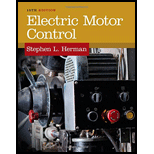
Concept explainers
What assurance is there that the rotor will lock into step at the synchronous speed with the use of a timing relay?
What is the assurance of the synchronization with the use of a timing relay to lock the rotor of a motor at the synchronous speed.
Answer to Problem 1SQ
The only assurance is that if the timing period of the relay is adjusted for the rotor’s maximum acceleration, then the rotor will be near the synchronizing speed.
Explanation of Solution
A motor can be operated at the synchronous speed by exciting the DC field using the definite time-delay relay in a timed, semiautomatic synchronizing installation process. In the starting cycle, the delay-in-closing contact TR of the timing relay is closed to accelerate the rotor until it reaches the synchronizing point. Timing relay has the timer setting; it can be adjusted to the maximum time required to accelerate the rotor to reach the synchronous point, and after completing the synchronizing process of the motor, the attempt may not be successful, or the rotor may reach the maximum near to the synchronous speed.
The time relay based push-button control and timed semiautomatic control of a synchronizing installation process of the rotor are not guaranteed in achieving the synchronization on every attempt; while it fails, it is necessary to repeat the starting cycle by adjusting the timer setting of the timing relay. In every attempt, the only assurance is that if the timing period of the relay is adjusted for the rotor’s maximum acceleration, then the rotor will be near the synchronizing speed.
Conclusion:
Thus, the only assurance is that if the timing period of the relay is adjusted for the rotor’s maximum acceleration, then the rotor will be near the synchronizing speed.
Want to see more full solutions like this?
Chapter 41 Solutions
Electric Motor Control
- Approximately how much time (in terms of electrical cycles) elapses from the moment the PFR opens to the moment the motor actually synchronizes?arrow_forwardIf the motor fails to achieve synchronous operation, what action is necessary?arrow_forwardName three characteristics that make the synchronous motor different from an induction motor.arrow_forward
- • T or F, modify the wrong part if False, please underline twice your answer if True or False. The rotor speed of an induction motor may run at higher speeds compared to its synchronous speed.arrow_forwardWhy must a synchronous motor never be started when DC excitation is applied to the rotatorarrow_forwardAfter a synchronous motor has reached the synchronizing speed, the best time to apply the field current is when the A. induced field current is increasing to a maximum value.B. south stator poles are opposite the south rotor poles.C. rotor poles are traveling faster than the stator poles.D. north rotor poles are directly opposite the south stator poles.arrow_forward
- is the following correct? True or false? If the rotor of the asynchronous motor is reversed in the rotating field, the machine starts to work as a generator.arrow_forwardWhy is it that the induction motor operate less than the synchronous speed?arrow_forwardQ25)I) i) Explain why the rotor speed of induction motor is less than the Synchronous Speed?arrow_forward

 Delmar's Standard Textbook Of ElectricityElectrical EngineeringISBN:9781337900348Author:Stephen L. HermanPublisher:Cengage Learning
Delmar's Standard Textbook Of ElectricityElectrical EngineeringISBN:9781337900348Author:Stephen L. HermanPublisher:Cengage Learning

